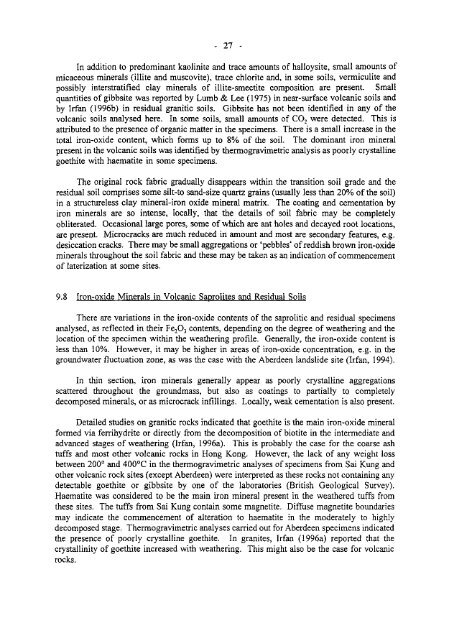mineralogical and fabric characterization and classification of ...
mineralogical and fabric characterization and classification of ...
mineralogical and fabric characterization and classification of ...
Create successful ePaper yourself
Turn your PDF publications into a flip-book with our unique Google optimized e-Paper software.
- 27 -In addition to predominant kaolinite <strong>and</strong> trace amounts <strong>of</strong> halloysite, small amounts <strong>of</strong>micaceous minerals (illite <strong>and</strong> muscovite), trace chlorite <strong>and</strong>, in some soils, vermiculite <strong>and</strong>possibly interstratified clay minerals <strong>of</strong> illite-smectite composition are present. Smallquantities <strong>of</strong> gibbsite was reported by Lumb & Lee (1975) in near-surface volcanic soils <strong>and</strong>by Irfan (1996b) in residual granitic soils. Gibbsite has not been identified in any <strong>of</strong> thevolcanic soils analysed here. In some soils, small amounts <strong>of</strong> CO 2 were detected. This isattributed to the presence <strong>of</strong> organic matter in the specimens. There is a small increase in thetotal iron-oxide content, which forms up to 8% <strong>of</strong> the soil. The dominant iron mineralpresent in the volcanic soils was identified by thermogravimetric analysis as poorly crystallinegoethite with haematite in some specimens.The original rock <strong>fabric</strong> gradually disappears within the transition soil grade <strong>and</strong> theresidual soil comprises some silt-to s<strong>and</strong>-size quartz grains (usually less than 20% <strong>of</strong> the soil)in a structureless clay mineral-iron oxide mineral matrix. The coating <strong>and</strong> cementation byiron minerals are so intense, locally, that the details <strong>of</strong> soil <strong>fabric</strong> may be completelyobliterated. Occasional large pores, some <strong>of</strong> which are ant holes <strong>and</strong> decayed root locations,are present. Microcracks are much reduced in amount <strong>and</strong> most are secondary features, e.g.desiccation cracks. There may be small aggregations or 'pebbles 4 <strong>of</strong> reddish brown iron-oxideminerals throughout the soil <strong>fabric</strong> <strong>and</strong> these may be taken as an indication <strong>of</strong> commencement<strong>of</strong> laterization at some sites.9.8 Iron-oxide Minerals in Volcanic Saprolites <strong>and</strong> Residual SoilsThere are variations in the iron-oxide contents <strong>of</strong> the saprolitic <strong>and</strong> residual specimensanalysed, as reflected in their Fe 2 O 3 contents, depending on the degree <strong>of</strong> weathering <strong>and</strong> thelocation <strong>of</strong> the specimen within the weathering pr<strong>of</strong>ile. Generally, the iron-oxide content isless than 10%. However, it may be higher in areas <strong>of</strong> iron-oxide concentration, e.g. in thegroundwater fluctuation zone, as was the case with the Aberdeen l<strong>and</strong>slide site (Irfan, 1994).In thin section, iron minerals generally appear as poorly crystalline aggregationsscattered throughout the groundmass, but also as coatings to partially to completelydecomposed minerals, or as microcrack infillings. Locally, weak cementation is also present.Detailed studies on granitic rocks indicated that goethite is the main iron-oxide mineralformed via ferrihydrite or directly from the decomposition <strong>of</strong> biotite in the intermediate <strong>and</strong>advanced stages <strong>of</strong> weathering (Irfan, 1996a). This is probably the case for the coarse ashtuffs <strong>and</strong> most other volcanic rocks in Hong Kong. However, the lack <strong>of</strong> any weight lossbetween 200° <strong>and</strong> 400°C in the thermogravimetric analyses <strong>of</strong> specimens from Sai Kung <strong>and</strong>other volcanic rock sites (except Aberdeen) were interpreted as these rocks not containing anydetectable goethite or gibbsite by one <strong>of</strong> the laboratories (British Geological Survey).Haematite was considered to be the main iron mineral present in the weathered tuffs fromthese sites. The tuffs from Sai Kung contain some magnetite. Diffuse magnetite boundariesmay indicate the commencement <strong>of</strong> alteration to haematite in the moderately to highlydecomposed stage. Thermogravimetric analyses carried out for Aberdeen specimens indicatedthe presence <strong>of</strong> poorly crystalline goethite. In granites, Irfan (1996a) reported that thecrystallinity <strong>of</strong> goethite increased with weathering. This might also be the case for volcanicrocks.
















